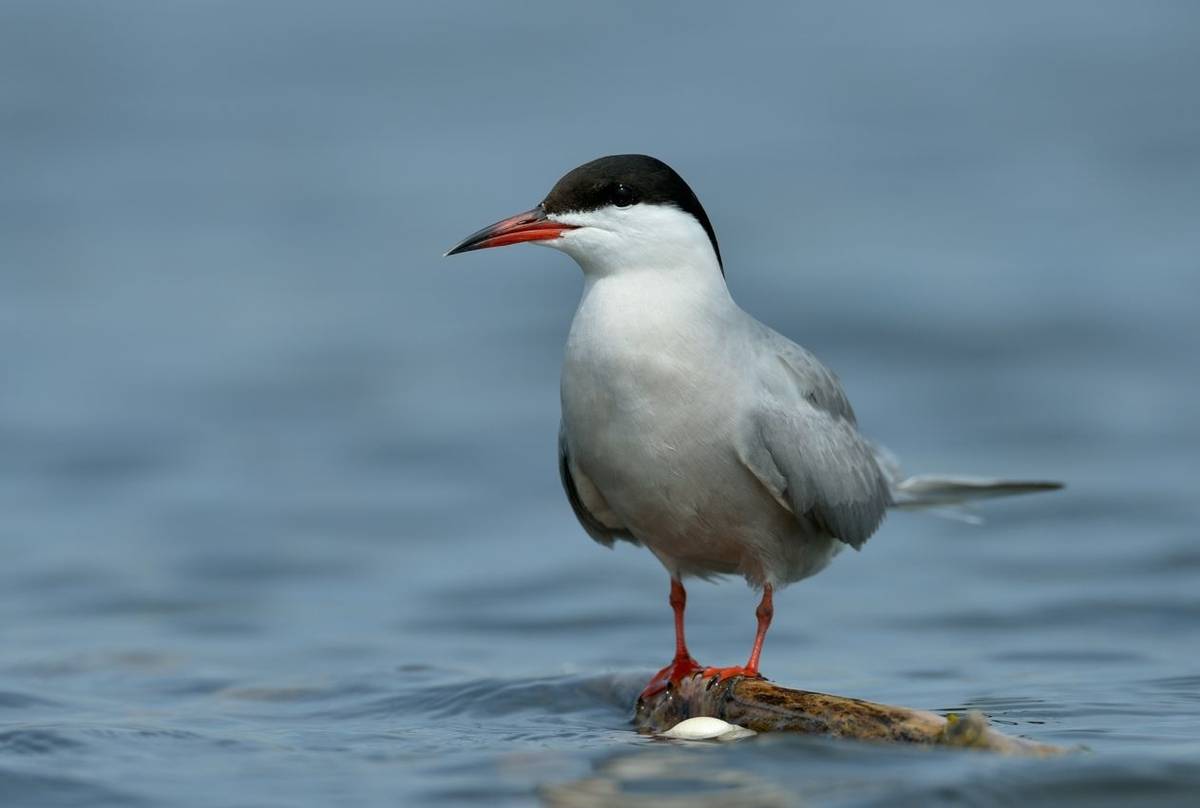A guided nature walk from Wivenhoe by a noted local naturalist and conservationist - Chris Gibson. Chris was a cheerful guide and walk leader who has extensive local knowledge of the buildings and history of Wivenhoe as well as the botany, geology, fungi, butterflies and birds of the area. He showed us estuarine birds, and pointed out several very rare and unusual plants and explained how the agriculture and gravel extraction activities had been managed to re-wild areas after commercial activities. The 10 km (or thereabouts) walk started in Wivenhoe, went Eastwards along the sea wall on the River Colne, then inland along a ridge known as the 'Essex Alps' to Cockaynes Wood nature reserve, then back through Wivenhoe and ended after a visit to the wild flowers and plants along the edge of the King George V playing field.
D.C. Essex, Aug 21



Tour Itinerary and Reports
Can I help you?
The Wild Side of Essex: The Colne Estuary (Day Trip)
Tour Code: GBR132From birds to botany, galls to geology, this day will lift the lid on the sometimes surprising ‘wild side of Essex’.
£60
Highlights
Tour Itinerary and Reports
Can I help you?
Quick Enquiry
Summary
Join all-round naturalist and conservationist Chris Gibson for an exploration of his home patch on the Colne Estuary in north Essex.
Our walks will be centred around the internationally important mudflats and saltmarshes with birds, especially in winter, and plants and insects in summer. Alongside the estuary, ancient woodland on the ‘Essex Alps’ always holds birds, with fungi and flowers in season. Other habitats likely to be visited include reedbeds and grazing marshes, restored gravel pits, historic parkland with rare and specimen trees, and the attractive waterfront of Wivenhoe, with its array of scarce and unusual plants which have recently colonised the area.
What you will see on any walk will be very different from the same walk in a different season, so why not plan on returning? Each walk is on a circular 8-10km route, which is easy going, although can be muddy in stretches after rain, but this is the driest part of the country! No driving is involved, so travel to Wivenhoe by train is practical for those who wish. From birds to bugs to botany, galls to geology, this day will lift the lid on the sometimes surprising ‘wild side of Essex’.
We have scheduled some departure dates which can be taken back-to-back with The Wild Side of Essex: Exploring The Naze and Walton Backwaters (Day Trip).
As we run this tour throughout the year, please click on our 'detailed information' below to read about the highlights of the different seasons.
- A perfect day for the all-round naturalist
- Raptors could include Marsh Harrier, Peregrine, Merlin plus Barn and Short-eared Owls
- Mammals may include Harbour and Grey Seals, with a chance of an Otter
- Waterbirds including Black-tailed Godwit, Avocet and Goosander
- A good chance for Siskin and Redpoll feeding in Alders
- Plants and fungi not overlooked
- Unrivalled local knowledge of naturalist and conservationist Chris Gibson
Winter (Nov-Feb):
Waterbirds feature heavily over winter, with Black-tailed Godwits, Avocets and Brent Geese prominent among a whole host of other wildfowl and waders, and hopefully also Kingfishers and raptors, including Marsh Harrier, Peregrine, Merlin and Barn and Short-eared Owls. Mammals could include Harbour and Grey Seals, with an outside chance of an Otter.
Inland waters are likely to have Goosanders, while in the parklands the magnificent trees from all over the world are attractive and interesting at any time of year. Areas of reedbed will hold (but not necessarily reveal!) Cetti’s Warblers, and waterside Alders may have Siskins and Redpolls among the roving bands of tits and other small birds.
If not too frosty, the grassland and heaths will continue to produce fungi and flowers, and even attract a few butterflies and other insects in winter sunshine.
Spring (Mar-May):
As spring progresses, the estuarine waterbirds decline in number, although those that remain begin to assume breeding plumage: Black-tailed Godwits are especially dramatic. Summer migrants return, with Common and Little Terns on the estuary, Sand Martins and Hobbies in the old gravel pits, warblers galore, and the unmistakeable song of Nightingales from several points along any of the routes. The reedbeds become alive with Reed and Sedge Warblers, usually with Cuckoos in close attendance, and by the end of spring a few Turtle Doves may be in residence.
Spring flowers feature in the woods, with magnificent displays of Bluebells and Wood Anemones, and more locally Opposite-leaved Golden Saxifrage and Town-hall-clock. Birdsong and blooming are an essential backdrop to the first flush of insects, from Emperor Moths and Orange-tips to Green Hairstreaks and the early damselflies.
Summer (Jun-Aug):
This is the time when there is so much to see that the walks may end up being significantly shorter in distance!
The estuarine saltmarshes reveal their botanical riches, with swathes of Sea Pink and Sea Lavender, as the sea walls light up with Salsify, Grass Vetchling and Strawberry Clover. Even the developed water frontage of Wivenhoe has its specialities, including Jersey Cudweed and Four-leaved Allseed. And at the height of summer, the heathland in the restored gravel workings holds one of the best displays of Heather in the county, along with its attendant insects and spiders.
Dragonflies include Emperor and Four-spotted and Scarce Chasers, while the flower-rich grasslands attract burnet moths and brown and skipper butterflies in abundance. Their main nectar sources – Black Knapweed, Field Scabious, Hogweed and Wild Carrot – also support a vast array of other interesting bees, flies, bugs and other invertebrates. The ancient woods should be featuring Purple Hairstreaks and White Admirals, and maybe even Purple Emperors. Wivenhoe is especially renowned for its Stag Beetles, and we may be lucky enough to encounter one of these lumbering giants.
Birds are breeding – Oystercatchers and Common Terns, warblers in the scrub, woods and reedbeds, Buzzards and woodpeckers in the parklands to name but a few – but also the first returning waders, usually in smart summer plumage, start to drift through from early July onwards.
Autumn (Sep-Oct):
Black-tailed Godwit and Avocet numbers in the estuary will be building rapidly, large flocks often viewable on a rising tide, with a host of other water birds, including the first arriving Brent Geese. Striking inland up onto the gravel ridge of the ‘Essex Alps’, there are plenty of scarce plants to occupy us, including the local speciality Lesser Calamint. Being autumn, migrant birds may turn up anywhere – although not guaranteed – and could include chats, warblers and the winter thrushes.
Salt marshes are in the full flush of autumn colour, with several species of Glasswort, and the last flowerings of Sea Aster and Golden Samphire, hopefully attracting butterflies and the rare Sea Aster Mining-bee, while reedbeds and grazing marshes will provide opportunities for birds such as Cetti’s Warblers. Willow Emerald damselflies, Common Darters and Migrant Hawkers are likely to be flying, and wherever there is flowering Ivy, it will be attracting late season butterflies, hoverflies and bees. If the preceding weather has been conducive, we may encounter an array of spectacular fungi, including coral fungi and brackets, Fly Agaric and earth-tongues, and the magnificent trees of the parklands can always be relied upon to provide a dazzling display of leaf colour from around the world.
For anyone wishing to extend their stay in north Essex, Wivenhoe has options for overnight accommodation. Most convenient is the Black Buoy public house, a community pub which has two rooms, and serves excellent food and real ale. It is just 5 minutes’ walk from our meeting point outside Wivenhoe Railway Station. Another option is Wivenhoe House Hotel, with a greater selection of rooms and a top-class restaurant, but a little further away – 5 minutes’ drive, 10 minutes on the bus, or 30 minutes’ walk to Wivenhoe Station. Chris is happy to recommend either of these options, and indeed to offer suggestions of other places you might like to visit as part of a longer stay.
Day Trip Location
Reviews
-
-
We spent a day walking around the Colne Estuary, starting at Wivenhoe, with an expert guide who provided information on the history, geology and natural history of the area. Impressively, he was able to answer all of the questions posed by the group, some quite challenging, and introduced us to a range of rare plants explaining why they were there. For me it was an introduction to a beautiful part of the country that I now appreciate with some understanding. I hope day trips like these will continue because they help us to understand and appreciate the fascinating variety of life that can be found in our own country. Naturetrek, as always, provided their welcoming, considerate and excellent all round service.
A.B. Cornwall, Aug 21 -
A beautiful walk along the Colne Estuary from Wivenhoe in a group of 7 with a superb guide. We were informed about birds, insects, local history and anything of natural interest. We returned via a nature reserve created from gravel bed workings which was also magical. Chris, our guide, was excellent, he is a mine of information and knowledge whose explanations are concise and clear.
J.M. Surrey, May 21 -
Day visit to the Colne Estuary at Wivenhoe. Excellent guide. delightful walk along the estuary and then up into the wooded escapement blanketed with blue bells, serenaded by nightingales and other birds, along to the flooded gravel pits, now part of an extended nature reserve.
D.L. Hertfordshire, May 21 -
The days walk with Chris Gibson was interesting and informative in spite of the mildly inclement conditions. He was able to point out many features which otherwise we would not have noticed. We will probably do the walk again at a different time of the year and state of the tide.
R.R. Essex, Oct 20 -
I just wanted to thank you all at Naturetrek for the wonderful £50 days out idea. They‘ve been a life saver and I’ve enjoyed them all immensely and looking forward to the next one in December. I’ve particularly enjoyed the two I’ve done with Chris Gibson, such an amazing man who gives us so much interesting information without it being information overload. Personally I don’t think there is anything that could be improved on any of the Days Out that I’ve been on.
V.B. Hertfordshire, Oct 20
Dates & Prices
2026

Tour Leader: Chris Gibson
Chris is an experienced and enthusiastic all-round naturalist, based in Essex, though still a Yorkshireman at heart. He recently retired (early!) from a long career with Natural England, during which he worked on such varied projects as the notification of SSSIs in Essex, offshore wind developments and the issues surrounding the potential reintroduction of Eurasian Lynx to the UK. Although a conservationist by profession, and an ecologist by training, everything Chris have done has been linked to his life-long passion for natural history. In 2009 he was lucky enough to receive the David Bellamy Award of the British Naturalists’ Association, recognising ‘a naturalist of distinction’. He’s also written and co-written many books and articles. Now he has the time and opportunity to return to his roots as a naturalist, and to do what he does best – trying to enthuse others about the natural world.

Tour Leader: Chris Gibson
Chris is an experienced and enthusiastic all-round naturalist, based in Essex, though still a Yorkshireman at heart. He recently retired (early!) from a long career with Natural England, during which he worked on such varied projects as the notification of SSSIs in Essex, offshore wind developments and the issues surrounding the potential reintroduction of Eurasian Lynx to the UK. Although a conservationist by profession, and an ecologist by training, everything Chris have done has been linked to his life-long passion for natural history. In 2009 he was lucky enough to receive the David Bellamy Award of the British Naturalists’ Association, recognising ‘a naturalist of distinction’. He’s also written and co-written many books and articles. Now he has the time and opportunity to return to his roots as a naturalist, and to do what he does best – trying to enthuse others about the natural world.

Tour Leader: Chris Gibson
Chris is an experienced and enthusiastic all-round naturalist, based in Essex, though still a Yorkshireman at heart. He recently retired (early!) from a long career with Natural England, during which he worked on such varied projects as the notification of SSSIs in Essex, offshore wind developments and the issues surrounding the potential reintroduction of Eurasian Lynx to the UK. Although a conservationist by profession, and an ecologist by training, everything Chris have done has been linked to his life-long passion for natural history. In 2009 he was lucky enough to receive the David Bellamy Award of the British Naturalists’ Association, recognising ‘a naturalist of distinction’. He’s also written and co-written many books and articles. Now he has the time and opportunity to return to his roots as a naturalist, and to do what he does best – trying to enthuse others about the natural world.
Prefer to Travel in a Private Group?
For any interested natural history club or society, we can arrange for a private departure of this tour.
Enquire
Why Naturetrek?
At Naturetrek we craft expertly-guided group and tailor-made wildlife holidays and cruises to all seven continents. On one of our holidays, you can be assured that our passionate team will enable you to experience and enjoy the best of the world's wildlife and natural spectacles in as comfortable and rewarding a manner as possible, caring as best we can for the environment in the process. We are proud to provide:
- The widest choice of wildlife holidays worldwide
- Tours managed and led by naturalists, for naturalists
- Outstanding value and exceptional customer service
Furthermore, as a Naturetrek client, our office team are always to on hand to help you – so if you have any queries about your holiday, whether before or after you have booked, we will be delighted to answer them on the phone. Please just give our team a call!



 Loading search...
Loading search...









